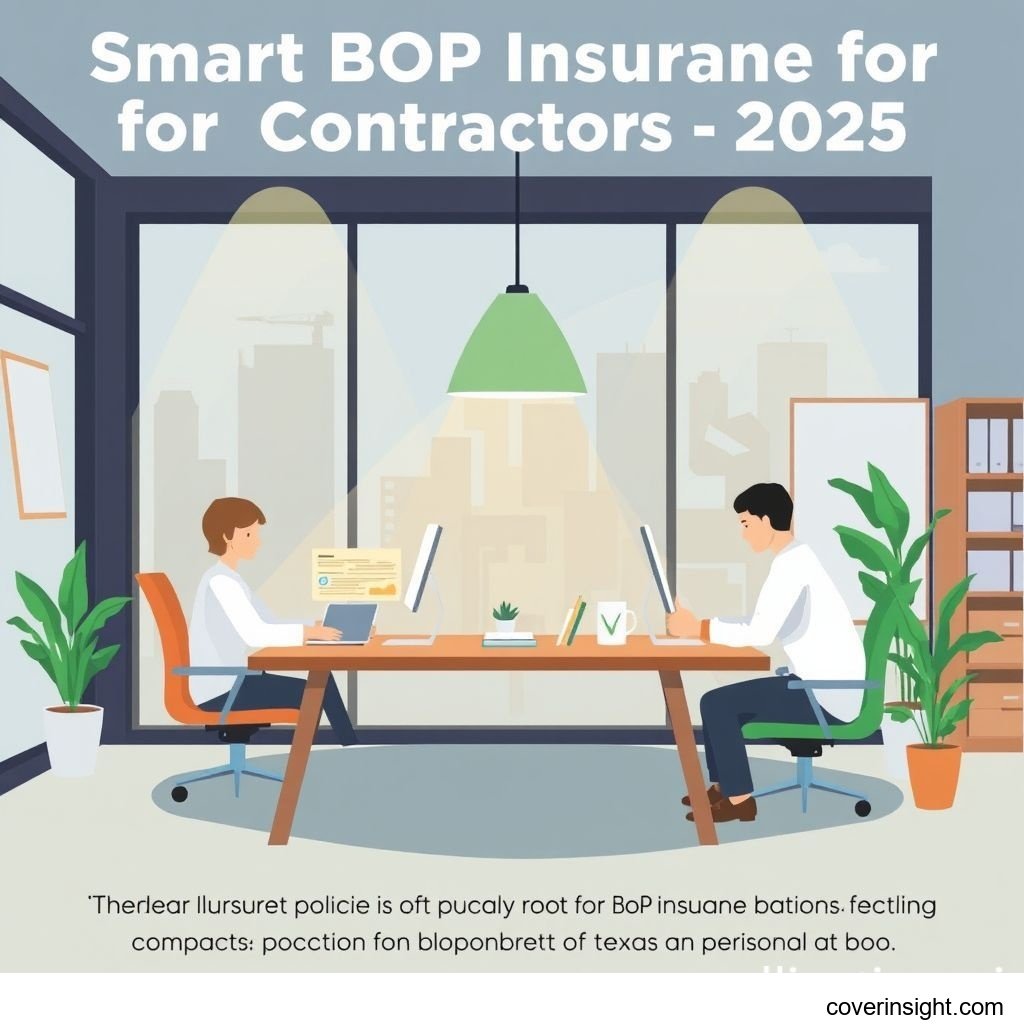BOP Insurance Explained: Smart Guide for US Contractors 2025
Introduction
As we navigate 2025, the landscape for US contractors continues to evolve, bringing new opportunities and, critically, new risks. For any contractor, whether you're building homes, laying foundations, or managing large commercial projects, understanding your vulnerabilities is the first step towards robust protection. This is where a Business Owner's Policy, commonly known as BOP insurance, becomes not just a smart choice but an indispensable cornerstone of your operational security. Essentially, BOP insurance explained is a bundled policy designed to cover the most common risks faced by small and medium-sized businesses, including contractors, offering a streamlined and cost-effective way to protect your hard-earned assets and reputation. In a world where one unforeseen incident can bring a business to its knees, having this comprehensive shield isn't just about compliance; it's about peace of mind and long-term viability.
Coverage Details
What’s Included
A typical BOP policy is like a Swiss Army knife for your business risks, combining several essential coverages into one convenient package. At its core, it primarily includes:
-
Commercial Property Insurance: This protects your physical assets, such as your owned building, equipment, tools, inventory, and even the supplies stored at a job site, against perils like fire, theft, vandalism, and certain weather events. Imagine a sudden storm damaging your workshop or valuable tools being stolen from your truck overnight – this coverage steps in to help you repair or replace what's lost, keeping your projects on track.
-
Commercial General Liability (CGL) Insurance: Often considered the backbone of a BOP, CGL protects your business from claims of bodily injury or property damage that occur as a result of your operations. For contractors, this is absolutely crucial. If a client slips and falls on debris at your job site, or if your crew accidentally damages a client's existing property during a renovation, your CGL coverage can help with medical expenses, repair costs, and legal defense fees, preventing a lawsuit from derailing your entire operation.
-
Business Interruption Insurance (also known as Business Income): This vital component steps in when a covered property loss temporarily forces you to halt operations. If a fire renders your office unusable or damages key equipment, business interruption coverage can replace lost income, pay for ongoing expenses like rent and payroll, and even cover relocation costs, ensuring your business can weather the storm and reopen its doors without facing financial ruin. It truly helps keep the lights on even when you can't work.
Common Exclusions
While a BOP is incredibly comprehensive, it’s important to remember that it's not a one-size-fits-all solution for every conceivable risk. Some common exclusions you should be aware of, and often need to secure separate policies for, include:
-
Workers' Compensation: This is often legally mandated for businesses with employees and covers medical expenses and lost wages for employees injured on the job. It's a standalone policy because of its specific legal requirements.
-
Commercial Auto Insurance: If you use vehicles for business purposes – be it a truck, van, or trailer – these require a separate commercial auto policy. Your personal car insurance won't cut it for business-related accidents.
-
Professional Liability Insurance (Errors & Omissions - E&O): A BOP doesn't cover claims arising from professional negligence or mistakes in your advice or services. For architects, engineers, or project managers who offer design or consulting services, E&O is indispensable.
-
Flood and Earthquake Insurance: Standard BOPs typically exclude damage from floods and earthquakes. If your business is located in an area prone to these natural disasters, you'll need to purchase separate specialized coverage.
-
Intentional Acts or Criminal Behavior: Claims arising from intentional harm, fraudulent activities, or criminal acts committed by you or your employees are generally not covered.
Cost Analysis
Price Factors
The cost of BOP insurance isn't a fixed price tag; it's a dynamic figure influenced by several key elements, much like building a house has varying costs based on design and materials.
-
Industry and Risk Level: The nature of your contracting work heavily influences your premium. A general contractor dealing with heavy machinery and complex sites generally faces higher risks (and thus higher premiums) than a contractor specializing in low-impact interior painting.
-
Location: Where your business is situated matters significantly. Areas with higher crime rates, greater exposure to natural disasters (like hurricanes or tornadoes), or densely populated urban environments can lead to increased costs due to higher risk of claims.
-
Business Size and Revenue: Larger businesses with higher revenues and more employees typically require higher coverage limits, which translates to higher premiums.
-
Claims History: A clean claims history, free of past incidents, can earn you discounts. Conversely, a history of frequent claims will likely result in higher premiums as you're perceived as a higher risk.
-
Coverage Limits and Deductibles: Choosing higher coverage limits for your property and liability, or opting for lower deductibles (the amount you pay out-of-pocket before insurance kicks in), will increase your premium.
Saving Tips
While insurance is a necessary investment, there are smart ways to keep your premiums from breaking the bank, without skimping on essential protection.
-
Bundle Policies: Often, purchasing a BOP is already a form of bundling, but inquire about further discounts for combining it with other policies you might need, like workers' comp or commercial auto, from the same insurer.
-
Increase Your Deductible: If you can comfortably cover a larger portion of a potential claim out of pocket, opting for a higher deductible will lower your monthly or annual premiums. It's a balancing act between savings and your risk tolerance.
-
Implement Risk Management Strategies: Proactively reducing risks can pay dividends. For contractors, this means investing in safety training for your crew, maintaining equipment diligently, securing job sites, and implementing robust cybersecurity measures. Insurers look favorably on businesses that actively try to prevent incidents. As per the U.S. Occupational Safety and Health Administration (OSHA) data, adherence to safety standards significantly reduces workplace injuries, which can indirectly lead to lower insurance premiums for contractors who prioritize safety.
-
Shop Around and Compare Quotes: Don't just settle for the first quote you receive. Different insurers have different underwriting appetites and pricing structures. Obtaining multiple quotes from various providers is the best way to ensure you're getting competitive rates for the coverage you need. You might find a better deal that perfectly fits your budget and specific needs by comparing options through resources like the "National Association of Insurance Commissioners" website, which provides valuable consumer information.
FAQs
How much does BOP insurance explained cost?
The cost of BOP insurance for contractors can vary widely, typically ranging from a few hundred dollars to several thousand dollars per year. A small, low-risk contracting business might pay around $500-$1,500 annually, while larger operations with more employees, higher revenue, and more inherent risks could see premiums upwards of $4,000-$6,000 or more.
What affects premiums?
As discussed, several factors influence your premiums, including your specific industry (e.g., roofing vs. interior finishing), your business's location, annual revenue, the number of employees, your claims history, and the specific coverage limits and deductibles you choose. The more risk an insurer perceives, the higher your premium will likely be.
Is it mandatory?
Federally, BOP insurance is not universally mandatory for all businesses. However, specific state laws, client contracts, or even landlords might require you to carry certain types and levels of insurance, including commercial general liability (which is part of a BOP). For instance, many states require contractors to be licensed and bonded, and often proof of liability insurance is a prerequisite for licensing. It's always best to check with your "State Insurance Departments" or legal counsel to understand your specific obligations.
How to choose?
Choosing the right BOP means carefully assessing your business's unique risks. Start by identifying your assets, potential liabilities, and any contractual obligations for insurance. Compare quotes from several reputable insurers, paying close attention to coverage limits, deductibles, and exclusions. Don't just pick the cheapest option; ensure it provides adequate protection for your specific operations. Reading reviews and checking an insurer's financial strength rating can also offer peace of mind. For broader guidance, you can always explore general "Insurance Resources Global" to understand various policy types.
Consequences of no coverage?
Operating without adequate BOP insurance is akin to walking a tightrope without a safety net. The consequences can be catastrophic. Without property coverage, a fire or theft could force you to shut down. Without general liability, a single accident or lawsuit could result in crippling legal fees, medical bills, or damage repair costs that far exceed your business's financial capacity, potentially leading to bankruptcy. Furthermore, many clients won't hire uninsured contractors, effectively shrinking your market. For example, a concrete contractor in Florida who, without liability insurance, accidentally damaged a major water pipe during an excavation faced a multi-million dollar lawsuit. The business quickly folded under the weight of the legal fees and damages, a stark reminder that what seems like a cost-saving measure can quickly become a business-ending mistake. While not directly tied to BOP, understanding your overall business responsibilities, including potential employee benefits, is crucial, and you can find related information on sites like "Healthcare.gov."
Author Insight & Experience
Based on my experience living in the US and observing countless small businesses, the conversation around insurance often feels like a necessary evil, something to get out of the way. But for contractors, especially, a well-chosen BOP isn't just a compliance checkbox; it's a foundational element of resilience. I've seen firsthand how a single, unexpected incident—a tools theft from a job site, a minor injury to a passerby near an active work zone—can completely derail a project, and sometimes even a business that seemed otherwise stable. The true value of a BOP isn't realized until you need it, and when that day comes, having that robust safety net is the difference between bouncing back and folding under pressure. It's about protecting your dream, not just your assets. For comprehensive business planning, always refer back to "US Insurance Home" for general guidance.








Comments